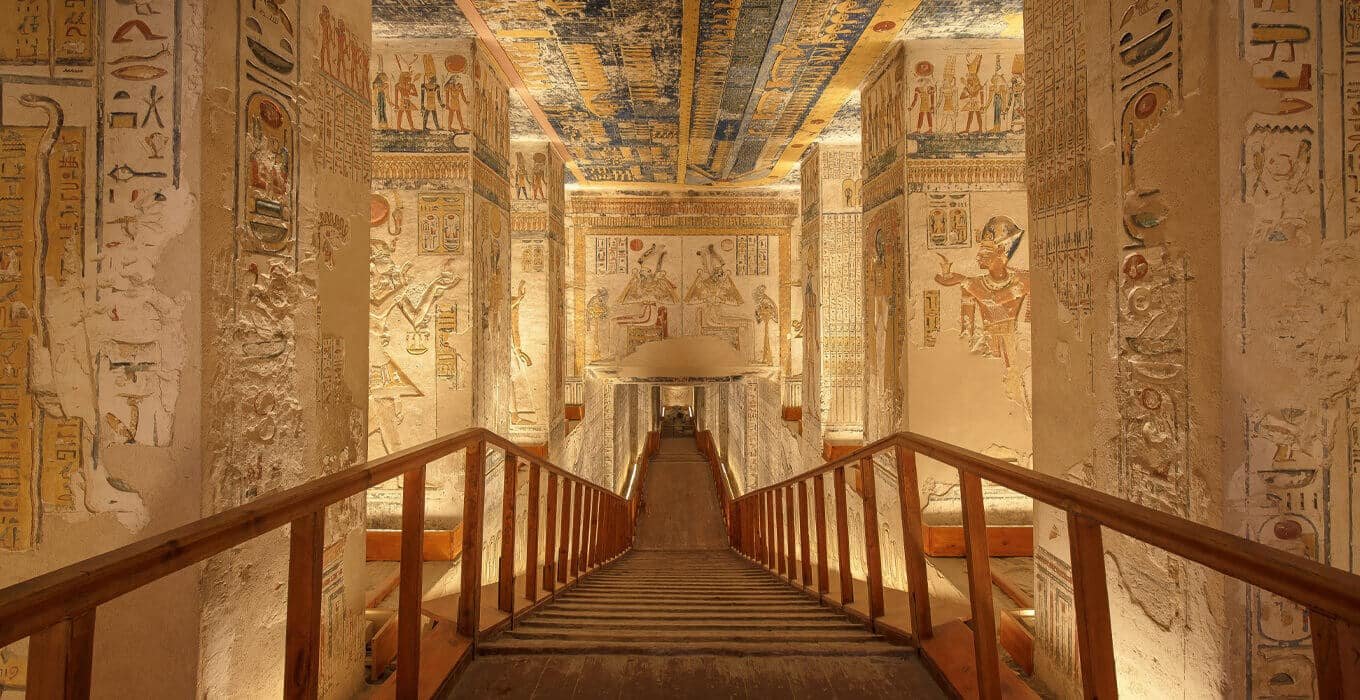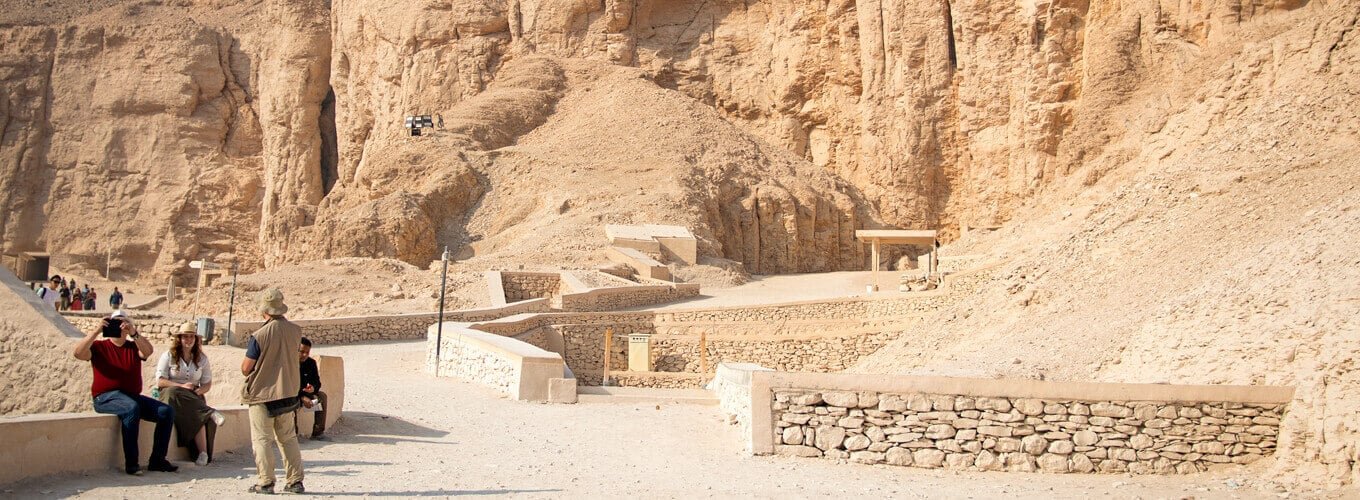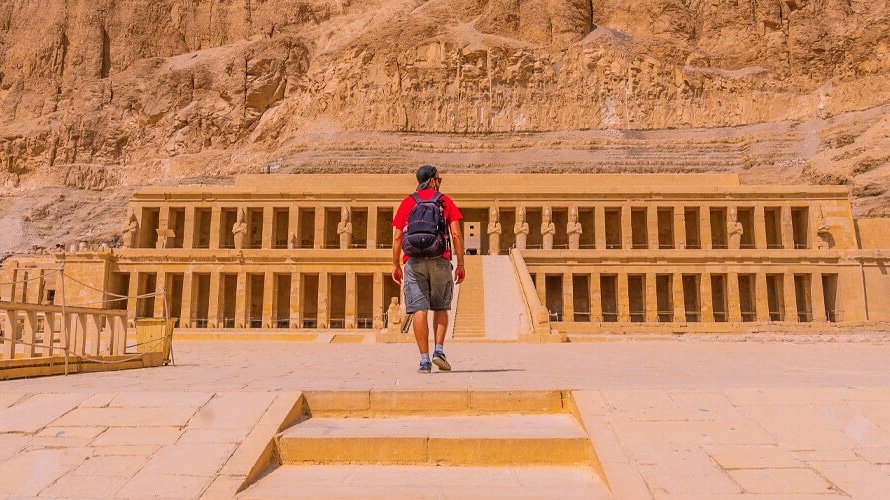The Valley of the Kings, tucked away on the west bank of the Nile in Luxor, Egypt, is an awe-inspiring testament to the grandeur of ancient Egypt’s New Kingdom. This arid valley served as the final resting place for some of Egypt’s most powerful pharaohs, their tombs carved deep into the heart of the desert mountains. For nearly 500 years (16th to 11th centuries BC), this was a place steeped in mystery and ritual, where elaborate subterranean tombs were constructed to safeguard the pharaohs’ passage into the afterlife.
These tombs weren’t just about death; they were vibrant celebrations of life and power. Their walls blaze with intricate hieroglyphics, illustrations depicting the pharaohs’ journeys, and scenes of deities and the underworld. The Valley of the Kings offers a unique and awe-inspiring window into the beliefs, art, and ambition that defined one of the world’s most remarkable civilizations.
How to Get to the Valley of the Kings
Start by emphasizing the Valley of the Kings’ location on the west bank of the Nile, opposite modern-day Luxor.
Transportation Options:
- Taxis: The most convenient option. Taxis are easily available in Luxor, and you can arrange a full-day or half-day hire to include other West Bank sites. Briefly mention price negotiation.
- Public Ferry + Taxi: A more budget-friendly approach. Explain the public ferry system from Luxor, then hiring a taxi once across the river.
- Organized Tours: Perfect for hassle-free sightseeing. Many tour operators offer excursions to the Valley of the Kings with transportation and guides included.
- Distances and Permits: Note that no special permits are needed, but mention the approximate travel time from Luxor (about 45 minutes by car) to help visitors plan.

Essential Tips for Visiting the Valley of the Kings
- Best Time of Year: Egypt’s cooler months (October-April) offer the most pleasant weather for exploring. Avoid the peak summer heat if possible.
- Weather Considerations: The desert climate is hot and dry year-round. Emphasize sun protection (hat, sunglasses, sunscreen) and ample water.
- Ticket Prices: Outline the standard entry fee, as well as additional costs for specific tombs (like Tutankhamun’s). Mention that most tombs are open on a rotation system.
- What to Wear: Lightweight, breathable clothing is ideal. Comfortable walking shoes are a MUST. Out of respect for local culture, modest attire covering shoulders and knees is recommended.
- Inside the Tombs: Flash photography is usually prohibited. Remind visitors to be respectful of the delicate antiquities.
Additional Tips:
- Consider bringing a small flashlight for poorly lit tomb areas.
- Allow plenty of time to explore, especially if you want to see multiple tombs.
Notable Tombs in the Valley of the Kings
- Tutankhamun’s Tomb (KV62): The discovery of Tutankhamun’s tomb, almost completely intact, was a sensation that ignited the world’s fascination with ancient Egypt. While smaller than other tombs, its treasures provide a breathtaking glimpse into the opulence of royal burial. Highlight the iconic golden mask and the sheer wealth of artifacts found within.
- Ramses VI (KV9): One of the largest and most vibrantly decorated tombs in the valley. Its ceilings depict stunning astronomical scenes, and the vivid colors are remarkably well-preserved.
- Seti I (KV17): Often considered the most beautiful tomb in the Valley of Kings. Its long, descending corridors and chambers are covered in exquisite reliefs showcasing Seti I’s power and his journey through the underworld.
- Ramses III (KV11): Known for its well-preserved colors and detailed reliefs depicting scenes of daily life and offering rituals. Its size and numerous side chambers hint at Ramses III’s prosperous reign.
- Thutmose III (KV34): A more challenging tomb to access, located high up in a cliff face and reached by a steep climb. The unique burial chamber is oval-shaped and adorned with star-patterned ceilings and enigmatic figures.
The Valley of the Queens and Other Nearby Sites
Briefly introduce the Valley of the Queens, the final resting place of pharaohs’ wives, sons, and daughters. Emphasize that its most famous tomb is the beautifully restored tomb of Queen Nefertari. Additionally, mention other key sites in the Theban Necropolis:
- Mortuary Temple of Hatshepsut: This impressive temple complex stands out against the desert cliffs.
- Colossi of Memnon: Two massive seated statues of Amenhotep III.
- Deir el-Medina: This village housed the artisans who created the royal tombs, offering additional insight into daily life in ancient Egypt.

Preserving the Legacy: Conservation Efforts at the Valley of the Kings
Explain why conservation is crucial: the tombs face threats from humidity, dust, and the impact of tourism. Outline current efforts:
- Limiting Visitor Numbers: Strict controls manage the flow of visitors to specific tombs.
- Monitoring and Restoration: Ongoing projects monitor the condition of tombs and undertake meticulous restoration work where needed.
- Research and Technology: Utilizing advanced techniques like 3D scanning to document and study the tombs, aiding future preservation.
FAQs
Is the Valley of the Kings worth visiting?
Absolutely! For anyone interested in ancient Egypt, the Valley of the Kings is an unmissable experience. It allows you to step back in time, exploring the grandeur and mystique of the pharaohs’ burial chambers. The elaborate artwork, the stories etched on the walls, and the sheer scale of the tombs create an undeniably captivating journey through history.
How much does it cost to visit the Valley of the Kings?
There are a few costs involved:
- General Admission Ticket: Provides entry to the Valley of the Kings and access to three tombs (excluding Tutankhamun’s). Current prices should be listed for accuracy.
- Tutankhamun’s Tomb: Requires an additional, separate ticket.
- Other Special Tombs: Some tombs may have an additional small entry fee.
Is photography allowed in the Valley of the Kings?
The photography policy is strict to protect the fragile antiquities inside. Generally, photography is NOT allowed inside the tombs themselves. Photography may be permitted in the outside areas of the Valley with a special mobile phone photography ticket. Be sure to check the latest policies before your visit.
What is the difference between the Valley of the Kings and the Valley of the Queens?
The Valley of the Kings was the primary burial site for the powerful pharaohs of the New Kingdom. The Valley of the Queens, located nearby, served as the resting place for their wives, children, and some high-ranking officials.
Are there guided tours of the Valley of the Kings?
Yes! Guided tours are a fantastic way to enrich your experience. Options include:
- Group Tours: Many tour operators offer half-day or full-day excursions, often combined with other Theban Necropolis sites.
- Benefits of Tours: Guides provide insightful commentary, help navigate the site, and may have access to areas not open to the general public.
Are there any facilities for visitors at the Valley of the Kings?
Yes, there are basic facilities available including:
- Visitor Center: Ticket office, information desk, and sometimes exhibits.
- Restrooms
- Small Cafes/Shops: Selling snacks, drinks, and souvenirs.
Conclusion
The Valley of the Kings stands as a timeless monument to the ambition, artistic mastery, and profound beliefs of ancient Egypt. These tombs are more than just burial sites; they are portals into a world where pharaohs sought to conquer death and journey towards eternity. From the electrifying discovery of Tutankhamun’s treasure-laden tomb to the mesmerizing artwork adorning the walls of other royal chambers, the Valley never ceases to amaze and inspire.
If Egypt is on your travel itinerary, a visit to the Valley of the Kings is an absolute must. Witnessing the legacy of the pharaohs firsthand will leave you with a profound appreciation for one of history’s most fascinating civilizations.
Related Article to Read:






